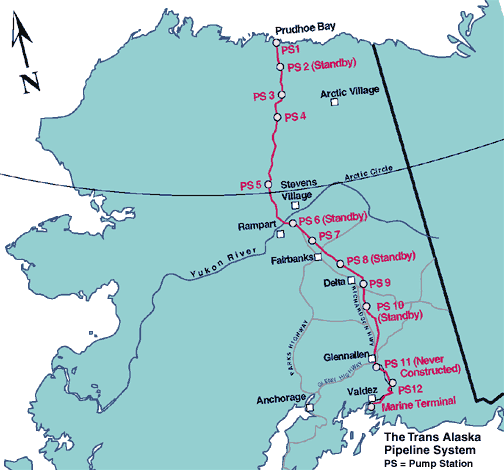Some Of The Best Salmon We've Had Each Year!
Trans Alaska Pipeline!

The Trans-Alaska Pipeline System (TAPS) includes the trans-Alaska crude-oil pipeline, 12 pump stations,
several hundred miles of feeder pipelines, and the Valdez Marine
Terminal. TAPS is one of the world's largest pipeline systems. It is
commonly called the Alaska pipeline, trans-Alaska pipeline, or Alyeska pipeline, (or the pipeline as referred to in Alaska),
but those terms technically apply only to the 800 miles (1,287 km) of
the pipeline with the diameter of 48 inches (122 cm) that conveys oil
from Prudhoe Bay, to Valdez, Alaska. The crude oil pipeline is privately owned by the Alyeska Pipeline Service Company.
The pipeline was built between 1974 and 1977 after the 1973 oil crisis caused a sharp rise in oil prices in the United States. This rise made exploration of the Prudhoe Bay oil field
economically feasible. Environmental, legal, and political debates
followed the discovery of oil at Prudhoe Bay in 1968, and the pipeline
was built only after the oil crisis provoked the passage of legislation
designed to remove legal challenges to the project.
The task of building the pipeline had to address a wide range of
difficulties, stemming mainly from the extreme cold and the difficult,
isolated terrain. The construction of the pipeline was one of the first
large-scale projects to deal with problems caused by permafrost,
and special construction techniques had to be developed to cope with
the frozen ground. The project attracted tens of thousands of workers to
Alaska, causing a boomtown atmosphere in Valdez, Fairbanks, and Anchorage.
The first barrel of oil
traveled through the pipeline in 1977, and full-scale production began
by the end of the year. Several notable incidents of oil leakage have
occurred since, including those caused by sabotage, maintenance
failures, and bullet holes. As of 2010, the pipeline has shipped almost 16 billion barrels (2.5×109 m3) of oil.
Dredge No. 8 Tour

Includes a Train Ride With Demonstrations of Various Mining Techniques!

Museum at University of Fairbanks
Next Stop!
Never Too Old to go Sledding - Even if Inside!
Ice Sculpting Demonstration For Our Group!
While Aboard The Riverboat Discovery We Saw
Float Plane Demonstration!
Susan Butcher Residence!
Susan Howlet Butcher (December 26, 1954 – August 5, 2006) was an American dog musher, noteworthy as the second woman to win the Iditarod Trail Sled Dog Race in 1986, the second four-time winner in 1990, and the first to win four out of five sequential years. She is commemorated in Alaska by the Susan Butcher Day.
Native Cultural Center
On To Denali!













































No comments:
Post a Comment